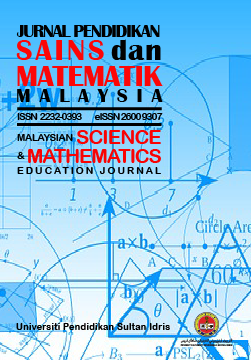Development of Practical Video Module (V-Lab) to enhance teaching and facilitation of form four biology
Pembangunan modul Video Amali (V-Lab) bagi mempertingkatkan pengajaran dan pemudahcaraan biologi tingkatan empat
DOI:
https://doi.org/10.37134/jpsmm.vol10.2.1.2020Keywords:
Development, biology practical, video module, teachingAbstract
This study aims to develop a biology practical video (V-Lab) and a practical manual to assist in teaching and facilitation of form 4 biology subject. The design of the study used is the development design and the model used is the ASSURE model. This study was conducted in a school laboratory and involved students as respondents. As a result, twelve biology practicals has been successfully videotaped. Each video was edited by the inclusion of text, music and shortened to a period of 60 seconds. The V-Lab and practical manuals are validated by experts with a 92% of expert agreement and have a Cronbach’s alpha reliability score of 0.82. The suitability of V-Lab and practical manual were also high (min = 4.25, sp = 0.67) from the students' point of view. The conclusion is that the V-lab and the practical manual are good and suitable for teaching and facilitating biology practical.
Downloads
References
Allchin, D. (2014). From science studies to scientific literacy: A view from the classroom. Science & Education, 23(9), 1911-1932.
http://dx.doi.org/10.1007/s11191-013-9672-8
Aubusson, P. (2011). An Australian science curriculum: Competition, advances and retreats. Australian Journal of Education, 55(3), 229-244.
https://doi.org/10.1177/000494411105500305
Altherr, S., Wagner, A., Eckert, B., & Jodi, H. J. (2004). Multimedia materials for teaching physics (search, evaluation and examples). European Journal of Physics. 25,7-14.
http://dx.doi.org/10.1088/0143-0807/25/1/002
Bravo, E., Amante-Garcia, B., Simo, P., Enache, M., & Fernandez, V. (2011). Video as a new teaching tool to increase student motivation. In Proceedings of 2011 IEEE Global Engineering Education Conference, 638-642.
http://dx.doi.org/10.1109/EDUCON.2011.5773205
Che Nidzam, C.A., Lilia, H., Meerah, T., Kamisah, O. & Arbaat, H. (2009). Malaysian science laboratory: Issues and constrains, Paper presented at the ESERA conference, Istanbul, Turkey, 28th August-4th September
Chiappetta, E.L. & Koballa, T.R. (2006). Science Instruction in the Middle and Secondary Schools. Ed. Ke-6. Upper Saddle River, NJ: Pearson/Merrill Prentice Hall.
Cohen, L., Manion, L., & Morrison, K. (2007). Research Methods in Education (6th ed.). London and New York, NY: Routledge Falmer.
Hakinson, B.L. & Rangsdale, T.W. (2000). Laboratory Safety Program at Francis Marion University. Journal of Chemical Health & Safety 7(2), 10-13.
Hodson, D. (2001). Research on practical work in school and universities: in pursuit of better questions and better methods. Proceedings of the 6th European conference on research in chemical education. University of Aveiro; Aveiro, Portugal.
Hofstein, A & Lunetta, V.N. (2004). The laboratory in science education: Foundations for Twenty-First Centuary. Science Education, 88 (1), 28-54.
https://doi.org/10.1002/sce.10106
Hofstein, A. & Lunetta, V.N. (2003). The laboratory in science education: Foundation for the twenty-first century. Science Education 88(1), 28-54.
Hofstein, A. (2004). The laboratory in Chemistry Education: Thirty years of experience with developments, implementation and research. Chemistry Education: Research and Practices, 5(3), 247-264.
Heinich R, Molenda M, Russell JD (1989). Instructional media and the new technologies of instruction (2nd edition). New York: John Wiley and Sons.
Kamarudin, N., Halim, L., Osman, K. & Mohd. Meerah, T.S. (2009). Pengurusan penglibatan pelajar dalam amali sains. Jurnal Pendidikan Malaysia 34(1), 205-217.
Kareem, A. A. (2018). The use of Multimedia in Teaching Biology and Its Impact on Students’ Learning Outcomes. The Eurasia Proceedings of Educational & Social Sciences (EPESS), 9 157-165.
Mei Chi Lee & Fauziah Sulaiman. (2018). The Effectiveness of Practical Work on Students’ Motivation and Understanding towards Learning Physics. International Journal of Humanities and Social Science Invention (IJHSSI), 7(8), 35-41.
Nabilah Sadali @ Talib. (2008). Evaluation of Science Teachers On The Efficacy Of Laboratory Activities. Tesis Master, Universiti Malaya. Tidak Diterbitkan.
Norlidah Alias. (2010). Pembangunan modul pedagogi berasaskan teknologi dan gaya pembelajaran Felder-Silverman kurikulum fizik sekolah menengah. Tesis PhD Universiti Malaya.,Malaysia.
Nur Liyana, A.,, Goh, C.T,, , Sharifah Zarina, S.Z.,, Sharina. A. H.,, Mazlin, M.,, Lee, K.E.,, & Lubna, A. Al (2018). Assessing Awareness on Laboratory Safety: A Case Study in Pahang, Malaysia, Jurnal Pendidikan Malaysia 43(2), 73-80
Kosterelioglu, l. (2016). Student Views on Learning Environments Enriched. Universal Journal of Educational Research 4(2): 359-369.
DOI: 10.13189/ujer.2016.040207
Polit, D.F., Beck, C.T. & Owen, S.V. (2007). Is the CVI an Acceptable Indicator of Content Validity? Appraisal and Recommendations. Research in Nursing & Health, 30, 459-467.
http://dx.doi.org/10.1002/nur.20199
Richey, R.C., & Klein, J.D. (2007). Design and developmental research. New York, NY : Routledge.
Ruslina Omar (2001). Masalah-Masalah dalam Pelaksanaan Pentaksiran Kerja Amali (PEKA) di Sekolah-Sekolah Menengah Daerah Temerloh. Tesis Sarjana Universiti Kebangsaan Malaysia, Malaysia.
Sidek Mohd Noah & Jamaludin Ahmad. (2005). Pembinaan Modul: Bagaimana Membina Modul Latihan dan Modul Akademik. Serdang: Penerbit Universiti Putra Malaysia.
Siti Aisyah Abd. Rahman & Suhaili Zakaria. (2004). Pendidikan Sains dan Teknologi di Malaysia: Tinjauan terhadap perlaksanaannya ke arah pembangunan Malaysia. Kertas kerja persidangan kebangsaan sains, teknologi dan masyarakat: ke arah pembangunan yang bersepadu. Universiti Malaya, Kuala Lumpur. 10-11 Disember.
Sousa, L.; Richter, B & Nel, C. (2017). The effect of multimedia use on the teaching and learning of Social Sciences at tertiary level: a case study. Yesterday and Today. 17.
Stoerger, S. G. (2013). Using video to foster presence in an online course. In E. G. Smyth & J. X. Volker (Eds.), Enhancing instruction with visual media: Utilizing video and lecture capture (pp. 166-176). Hershey, PA: IGI Global.
Taiwo, S. K & Emeke, E. A. (2014). Relationship among learning style preference, gender, age and students’ achievement in senior secondary school biology. West African Journal of Education, XXXIV
Ting, K. S. & Woo, Y. L., (2005), Penggunaan ICT Dalam Proses Pengajaran Dan Pembelajaran Di Kalangan Guru Sekolah Menengah Teknik Dan Vokasional: Sikap Guru, Peranan ICT Dan Kekangan / Cabaran Penggunaan ICT, Fakulti Pendidikan UTM, Seminar Pendidikan 2005, Fakulti Pendidikan UTM, 15 Oktober 2005
Wheeler, G. F. (2000). Three faces of inquiry. In E.H. Minstrell & Van Zee (Eds.), Inquiring into inquiry learning and teaching in science (ms 14-19), Washington, DC: American Association for the Advancement of Science, 164.
Zol Azlan. (2000). “Strategi Pengajaran: Pendekatan Sains, teknologi masyarakat” Selangor: Prentice Hall.





